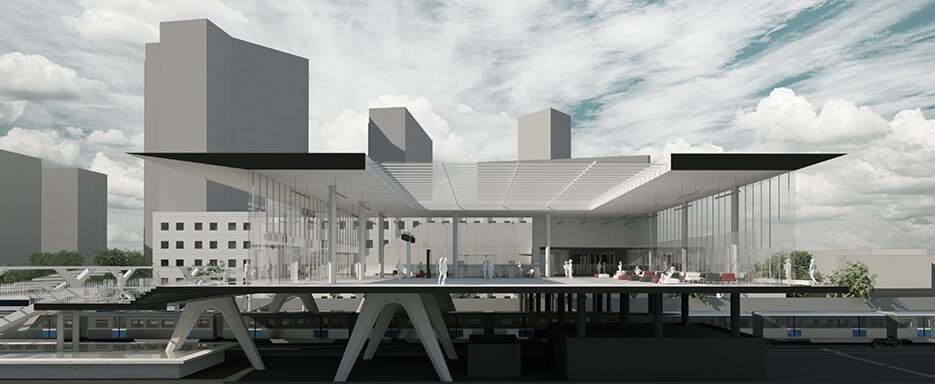Dong-gu, Gwangju, is a place with a strong pulse of urban and political heritage. Every time I come down, I look into the alleys from Jeonnam Provincial Office to Chungjangro 5-ga to see the changes over time. In the 1980s, Gwangju Dong-gu was dark, but it was a time when rapid urban expansion took place, centered around the old City Hall intersection and the Jeonnam Provincial Office area. Even now, stylish traces based on challenging modern architectural styles and strong regionalism remain here and there on the back roads. The Asian Culture Center covered up this valuable city heritage like a tsunami. Destruction of existing context by heterogeneous microstructure. My birthplace, my parents' home, the alleys I had frequented for over 20 years, and all the memories and places of memory were swept away with the construction of the Asia Culture Center. Although it was the Asian Culture Center that many residents supported by giving up their livelihood and homes in exchange for low compensation, this huge mass is becoming a disconnected stagnant waste. Businessmen who had hoped for the regeneration of the old downtown began to leave due to the decrease in population inflow, and the leadership of the old City Hall Intersection, Chungjang-ro, and Geumnam-ro, which were the heart of Gwangju, was lost to Sangmu and Cheomdan. The brutality of the space shown by this identityless giant ‘civil engineering project’ imported from the United States and built in my hometown. Thanks to this, I entered the profession of architecture. As a resident, this is where I was born and lived, and I felt that I had to do something, so I joined Samwoo Design, which was the domestic design partner for the Asian Culture Center construction project at the time. What can I do about the twists, turns, disappointments, and frustrations that follow? The building, which was said to be lowered to the ground floor, claimed to be isolated due to lack of accessibility and visibility, and the ramps that were inevitably formed due to the level difference took up unnecessary building areas and became a strange skip floor. The plaza is a place where context and people symbolically and physically converge and diverge, and comfortable access must be guaranteed. In the past, the Jeonnam Provincial Office area functioned normally as a democratic plaza where public gatherings were easily held. Currently, this place is no longer physically capable of becoming a plaza. The ‘Forest of Light’, which was intended to be a wonderful open space, became a ‘forest of a maze’ during the day and a ‘forest of cover’ at night due to finely segmented movement lines and obstacles. It completely failed in public. I feel embarrassed when I see visitors struggling to find their way, buried in their isolated identity. Couldn’t it be a space where social thinking takes precedence over architectural thinking? This is neither best nor optimal. It's just civil work that we have to endure because it was built. That could be the case. Isn’t that too big of a misjudgment? Today is a spring day. The area of the Asian Culture Center in Dong-gu, Gwangju, which I visited again with my father. A nice day, a walk with my father.
광주 동구는 도시 유산과 정치 유산이 산재해있는 강한 맥이 흐르는 곳이다. 내려올 때마다 전남도청에서 충장로5가까지 골목골목 살펴보며 그간의 변화를 살펴본다. 80년대 광주 동구는 어두웠지만, 구 시청 사거리와 전남도청 일대를 중심으로 급격한 도심지 확장이 이루어졌던 시기였다. 지금도 이면도로에는 도전적 근대건축 양식과 강한 지역성에 기반한 멋스러운 흔적들이 곳곳에 남아있다. 아시아문화전당은 이런 값진 도시의 유산을 쓰나미처럼 덮어버렸다. 이질적 거대 구조물에 의한 기존의 문맥 파괴. 나의 생가, 부모님의 삶의 터전, 20년 넘게 드나들던 골목길들, 모든 추억과 기억의 공간들이 아시아문화전당 건설과 함께 쓸려나갔었다. 수많은 주민들이 낮은 보상금에 생계와 터전을 양보하며 지지했던 아시아문화전당이었건만, 이 거대한 덩어리는 단절된 고인물이 되어가고 있다. 구도심 재생을 기대했던 상공인들은 인구유입 감소로 떠나기 시작했고, 광주의 심장부였던 구 시청 사거리, 충장로, 금남로는 주도권을 상무와 첨단으로 내어주고 말았다. 미국에서 수입되어 고향 땅에 들어선 이 정체성 없는 거대 ‘토목공사’가 보여주는 공간의 포악성. 덕분에 나는 건축이라는 직업에 발을 담갔었다. 주민으로서 내가 나고 살았던 곳인데 뭐라도 해야한다는 생각으로 당시 아시아문화전당 건립공사 국내 설계 파트너였던 삼우설계라는 곳에 입사했었다. 이후 우여곡절과 실망, 좌절은 언급해서 뭐하겠나. 지층으로 몸을 낮췄다는 건물은 접근성과 시인성 부재로 고립을 자처했고, 레벨 차로 부득이 형성된 램프들은 불필요한 건축 면적을 점유하며 기이한 Skip Floor가 되어 버렸다. 광장은 문맥과 사람이 상징적, 물리적으로 수렴발산 되는 곳으로 Comfort한 접근이 보장되어야 한다. 과거 전남도청일대는 대중 집회가 수월한 민주 광장으로 정상 작동했었다. 현재 이곳은 더이상 물리적으로 광장이 될 수 없는 구조다. 열린 공간이라 근사하게 의도되었던 ‘빛의 숲(Forest of Light)’은 잘게 분절된 동선과 지장물로 낮에는 ‘미로의 숲’, 밤에는 ‘엄폐물의 숲’이 되었다. 공공성에서 철저히 실패했다. 고립된 정체성에 매몰되어 길을 찾아 헤매고 있는 방문자들을 보니 내가 다 낯이 뜨거워진다. 건축적 사고보다 사회적 사고가 앞서는 공간이 될 수는 없었나. 이것은 최선도 최적도 아니다. 그저 지어졌으니 우리가 버텨내야 할 Civil Work일 뿐. 그럴 수도 있지 하기엔 너무 큰 오판 아닌가. 오늘 봄날. 아버지와 함께 다시 찾은 광주 동구 아시아문화전당 일대. 좋은 날 아버지와의 산책이다.



























